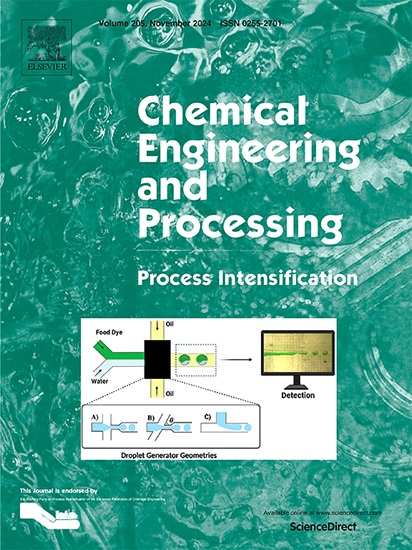Multi-objective geometric optimization of protrusion, droplet ribs, and inclined upper plate of a slit jet impingement heat sink to enhance its thermal performance
IF 3.8
3区 工程技术
Q3 ENERGY & FUELS
Chemical Engineering and Processing - Process Intensification
Pub Date : 2025-02-01
DOI:10.1016/j.cep.2024.110076
引用次数: 0
Abstract
To meet the needs of heat transfer and temperature uniformity in the heat dissipation of high-heat-flux electronic devices, a novel slit jet impingement heat sink with a protrusion in the stagnation region, droplet ribs in the wall jet region, and an inclined upper-plate (PDI-SJIHS) is proposed, the coolant is Al2O3![]() H2O nanofluid. The influences of the structural parameters of the above three components and the Reynolds number on the heat transfer and flow of the PDI-SJIHS are studied numerically. Using the comprehensive heat transfer and temperature standard deviation as objective functions, a multi-objective optimization of PDI-SJIHS is conducted using non-dominated sorting genetic algorithm-Ⅱ (NSGA-Ⅱ). The results indicate that the combination of the three components enhances the thermal performance of the PDI-SJIHS, compared with the slit jet impingement heat sink with only one of the above components. Rising the Reynolds number can enhance the thermal characteristics of the PDI-SJIHS. For a Reynolds number of 8000 and nanofluids with a 3 % volume fraction, the average convective heat transfer coefficient, friction coefficient, and comprehensive heat transfer coefficient of the optimized PDI-SJIHS are increased by 182 %, 153 %, and 108 %, respectively, and the standard deviation of temperature is 91 % less than that of F-SJIHS.
H2O nanofluid. The influences of the structural parameters of the above three components and the Reynolds number on the heat transfer and flow of the PDI-SJIHS are studied numerically. Using the comprehensive heat transfer and temperature standard deviation as objective functions, a multi-objective optimization of PDI-SJIHS is conducted using non-dominated sorting genetic algorithm-Ⅱ (NSGA-Ⅱ). The results indicate that the combination of the three components enhances the thermal performance of the PDI-SJIHS, compared with the slit jet impingement heat sink with only one of the above components. Rising the Reynolds number can enhance the thermal characteristics of the PDI-SJIHS. For a Reynolds number of 8000 and nanofluids with a 3 % volume fraction, the average convective heat transfer coefficient, friction coefficient, and comprehensive heat transfer coefficient of the optimized PDI-SJIHS are increased by 182 %, 153 %, and 108 %, respectively, and the standard deviation of temperature is 91 % less than that of F-SJIHS.

为了满足高热流密度电子器件在散热过程中传热和温度均匀性的要求,提出了一种新型的狭缝式射流撞击式散热器,该散热器在滞流区具有突起,在壁面射流区具有液滴肋,并具有倾斜上板(PDI-SJIHS),冷却剂为Al2O3H2O纳米流体。数值研究了上述三种部件的结构参数和雷诺数对PDI-SJIHS传热和流动的影响。以综合传热和温度标准差为目标函数,采用非支配排序遗传算法-Ⅱ(NSGA-Ⅱ)对PDI-SJIHS进行多目标优化。结果表明,与仅使用其中一种元件的狭缝射流冲击散热器相比,这三种元件的组合可以提高PDI-SJIHS的热性能。提高雷诺数可以增强PDI-SJIHS的热特性。在雷诺数为8000、纳米流体体积分数为3%的条件下,优化后的PDI-SJIHS的平均对流换热系数、摩擦系数和综合换热系数分别提高了182%、153%和108%,温度标准差比F-SJIHS小91%。
本文章由计算机程序翻译,如有差异,请以英文原文为准。
求助全文
约1分钟内获得全文
求助全文
来源期刊
CiteScore
7.80
自引率
9.30%
发文量
408
审稿时长
49 days
期刊介绍:
Chemical Engineering and Processing: Process Intensification is intended for practicing researchers in industry and academia, working in the field of Process Engineering and related to the subject of Process Intensification.Articles published in the Journal demonstrate how novel discoveries, developments and theories in the field of Process Engineering and in particular Process Intensification may be used for analysis and design of innovative equipment and processing methods with substantially improved sustainability, efficiency and environmental performance.

 求助内容:
求助内容: 应助结果提醒方式:
应助结果提醒方式:


